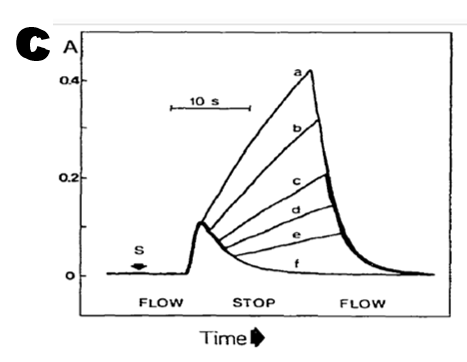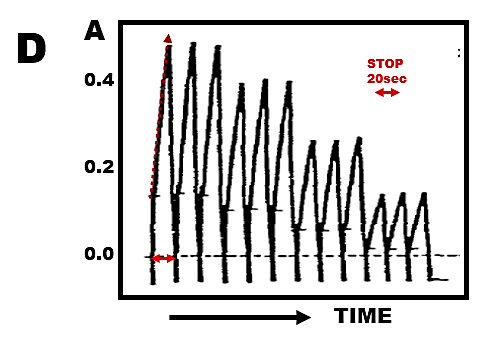2.1.5. Stopped flow reaction rate based method
Stop flow reaction rate-based assay is used either for substrate determination by using enzyme as reagent or for measurement of enzyme activity in presence of excess of substrate.
The flow channel between confluence point and flow cell in the two-stream manifold (A) is short (15 cm 0,8 mm I.D. volume 75 µL) to minimize time during which reaction mixture travels into the flow cell (1.2 seconds). In this way the majority of reaction product, to be measured, during 20 second stop flow period, will be generated within the flow cell. This is one of two ways in which sensitivity of determination is maximized. The second one is the positioning of reaction mixture within the flow cell in such a way that flow cell is entirely filled (a) with rection product (yellow) during the stop flow monitoring period (B). Later on as the transit time increases the reaction rates at b, c, d decrease, because concentration of the reaction product decreases, being progressively diluted by carrier solution on the trailing edge of the sample zone.
 The reaction rate of decomposition of glucose (10 mM ) by glucose dehydrogenase followed by NADH monitoring at 340 nm, (C) decreases (a to d), - because the beam integrates composition of product/carrier content within the flow cell. Obviously, to obtain reproducible results, the flow rate, transit time, stop flow period and injected sample volume must be rigorously reproduced, a task difficult to fulfill when peristaltic pump is used to control the flow (2.1.8.1.Fig B).
The reaction rate of decomposition of glucose (10 mM ) by glucose dehydrogenase followed by NADH monitoring at 340 nm, (C) decreases (a to d), - because the beam integrates composition of product/carrier content within the flow cell. Obviously, to obtain reproducible results, the flow rate, transit time, stop flow period and injected sample volume must be rigorously reproduced, a task difficult to fulfill when peristaltic pump is used to control the flow (2.1.8.1.Fig B).
 Analysis of glucose standards (10.0, 7.5, 5.0, 2.5, mM) measured in triplicate by using transit time 1,2 seconds and stop time 20 seconds show linear reaction rate response to glucose concentration (D).
Analysis of glucose standards (10.0, 7.5, 5.0, 2.5, mM) measured in triplicate by using transit time 1,2 seconds and stop time 20 seconds show linear reaction rate response to glucose concentration (D).
 The principal advantage of reaction rate measurement is that its result is independent of initial blank value. Thus initial absorbance of NADH in serum does not interfere with increase of absorbance during reaction rate measurement (red arrow in D). (D 9), Similarly sulphite can be determined in red wine by spectrophotometry at 580 nm with pararosaline that forms pink compound with SO2. (D 71)
The principal advantage of reaction rate measurement is that its result is independent of initial blank value. Thus initial absorbance of NADH in serum does not interfere with increase of absorbance during reaction rate measurement (red arrow in D). (D 9), Similarly sulphite can be determined in red wine by spectrophotometry at 580 nm with pararosaline that forms pink compound with SO2. (D 71)
J. Ruzicka & E.H. Hansen, “Flow Injection Analysis” 2nd ed. J.Wiley,N.Y.1988p.162.